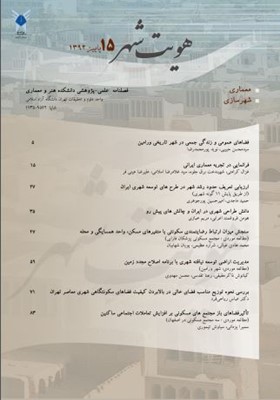ارزیابی تعریف حدود رشد شهر در طرح های توسعه شهری ایران (از طریق پایش 11 گونه شهری)
محورهای موضوعی : معماریحمید ماجدی 1 , امیرحسین پورجوهری 2 *
1 - دانشیار شهرسازی ، دانشکده هنر و معماری ، واحد علوم و تحقیقات، دانشگاه آزاد اسلامی، تهران- ایران
2 - دانش آموخته دکتری شهرسازی، دانشکده هنر و معماری ، واحد علوم و تحقیقات، دانشگاه آزاد اسلامی، تهران- ایران
کلید واژه: رشد شهر, مدیریت رشد شهر, حدود رشد شهر, شاخص خطای تعریف محدوده, شاخص ناکارایی محدوده,
چکیده مقاله :
شهرهای ایران با سرعت بالایی در حال رشد هستند. ابزار طرح های توسعه شهری در زمینه مدیریت رشد در خلال 5 دهه گذشته ، تعریف حدود رشد[i] بوده که کماکان بدون تغییر بنیادین استفاده می گردد. با وجود شواهد نسبی مبنی بر نامناسب بودن این ابزار ، هنوز به جای آن جایگزین مطمئن و مورد توافقی ارائه نشده است. عدم تلاش در زمینه اتخاذ راهکارهای جایگزین در زمینه مدیریت رشد تا حد زیادی به نبود بررسی های علمی در زمینه میزان توفیق ابزار کنونی بر می گردد. این بحث به واکاوی مدیریت رشد شهر از طریق تعریف دو شاخص سنجش شامل خطای تعریف و نیز ناکارایی در 11 گونه شهری ( طی 4 دهه اخیر) پرداخته است. نتایج حاصل نشان می دهد ابزار کنونی در دو بعد روایی و کارایی دست به گریبان مشکلات بنیادین است به نحوی که لزوم تجدید نظر در این ابزار را ایجاب می نماید.
One of the most ingenuous realties about cities is their perdurability. Expansion of city peripheries –desired or not desired – causes such areas to be annexed to the main body of the city. As in many developing countries, Iranian cities are growing in population and physically expanding at a high rate. For approximately the past five decades, after formulation of the first series of urban development plans, defining the urban growth boundary (UGB) has been an important policy tool of (central) government and urban management agencies. Provision of urban development plans in Iran is under the authority of the central government. Throughout this period, and despite clear evidence indicating the ineffectiveness of the UGB whose policy has been adhered to with no major modifications. Perhaps lack of effort in this area goes back to the absence of scientific studies in the field of level of success of the policies and available tools. It is such an extent that current trend of urban growth management is considered as an appropriate approach. This article, while paying attention to relevant theoretical topics, analyses urban growth management and boundary in Iran .Evaluation of the current growth management process is conducted through definition of special quantitative indices and sample monitoring using non-parametric analysis techniques in GIS.UGB definition error reveals the ignored part of the primary city at the time of provision of urban development plans, located outside the UGB. Thus, this index can represent the credibility of the proposals of urban development plans for the definition of the UGB. It is obvious that neglecting some parts of urbanized areas can cause future inefficiencies in urban growth management.UGB inefficiency index shows the proportion of the final, developed urban area that extends outside of the approved final urban growth zone, that is, outside of the approved UGB. This index reveals the efficiency of the UGB in incorporating urban growth and preventing urban sprawl. This is, then, a reliable basis for evaluation of the efficiency of urban growth management.As a result through a quantitative framework, this research demonstrates the weaknesses in the current procedure (inaccuracy and inefficiency of UGB). The evaluations reveal that the former and current definition of UGB in Iranian urban development plans have not been without error. This is partly because of incorrect assumptions with respect to urbanized areas in urban development plans. In some cases, because of intentional or unintentional mistakes in classifying a part of an urbanized area outside of the urban limits, the UGB does not even cover the real city edge in urban development plans. Another issue is the inefficiency of defined limits in restricting urban growth. Apart from the reality of to what extent the restrictive policies over urban growth are justifiable and necessary, it seems that some part of urbanization occurs outside of the approved urban limits. These two fundamental blunders cast doubt over the accuracy and credibility of the urban management mechanisms in Iran. Applicable results from the research include the necessity to revise the current policy tools.
_||_

